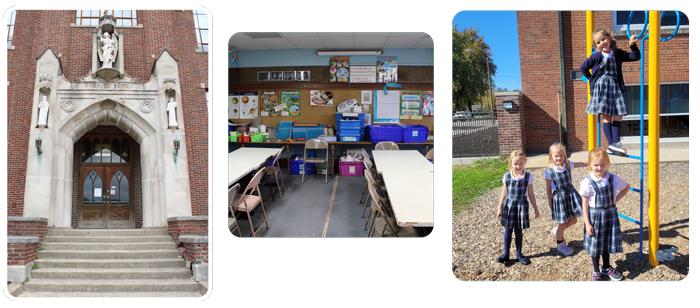The Challenge
Generations of students attended school in our old 1926 building. Its classrooms, auditorium, gymnasium, and cafeteria have been an essential part of our parish history. Today, its severe safety and maintenance issues render it almost entirely unused.
Yet, St. Gabriel School continues to provide our students with a faithful, enriched, and complete education – which requires updated facilities.

MAKING ROOM TO GROW
1926 Building Demolition
- Only about 250 square feet of the building’s total 23,000 are used. It has asbestos in tiles and insulation, non-functioning third-floor plumbing, no HVAC system, a leaky roof, and loose exterior bricks. Its electrical infrastructure needs much work. Most, if not all of the windows need to be replaced.
- The parish pays nearly $20,000 annually just to insure this building.
- In 2017, a contractor estimated renovation costs to bring the building up to current codes and make it usable. Its estimated cost was at least $9 million; yet, the improvements would still fall short of current educational standards and would not meet our overall needs.
Teaching Spaces That Work
St. Gabriel School strives to provide our students with a faithful, enriched, and complete education; however, we don’t have adequate facilities. Some of our specialized classes are held in spaces not designed for classroom instruction. This impacts learning and limits our teachers’ ability to implement their best teaching methods.
Room for Art & Music
Currently, art and music classes share space with the school’s multipurpose room which was not designed as a classroom and impacts its use for other purposes.
- The multipurpose room is not an ideal classroom learning space, especially for music and art classes that require specialized supplies, storage, and cleanup.
- Our students’ education is impacted because teachers must adapt their lessons to the space and what materials can be available for the topic they are teaching.
- The room has inadequate clean-up facilities for creative but messy art projects and hand washing.
Additionally, using the multipurpose room as a classroom means it no longer serves as a dedicated space for teachers, special services instruction, and general meeting space.
Space Especially for Science
Our students’ science education is impacted by the limitations of our science room. It does not support hands-on experiments and learning.
- Our science class is currently held in the only classroom that’s used in the 1926 building, which is isolated, inconvenient, and inaccessible to students and staff with mobility issues.
- The room is not adequately designed or equipped – limiting the effectiveness of our children’s science education.
Teaching Toddlers
Preschoolers have unique needs and their room’s challenges make it difficult for our teachers to adequately serve the needs of these youngest and smallest students.
- Our program has many age-appropriate materials essential for small students' learning and development, but the room doesn’t have enough storage. As a result, teachers must frequently have their supplies transported from storage in other building areas or off-site locations.
- The room’s small space requires teachers to spend time rearranging furniture or moving the children to other building areas to provide room for movement and play.
- It is challenging for teachers to manage small students’ clean-up and restroom needs. The preschool room doesn’t have a child-friendly sink or restroom, so children must be escorted to restrooms in other building areas, which requires additional staff and introduces safety concerns.
